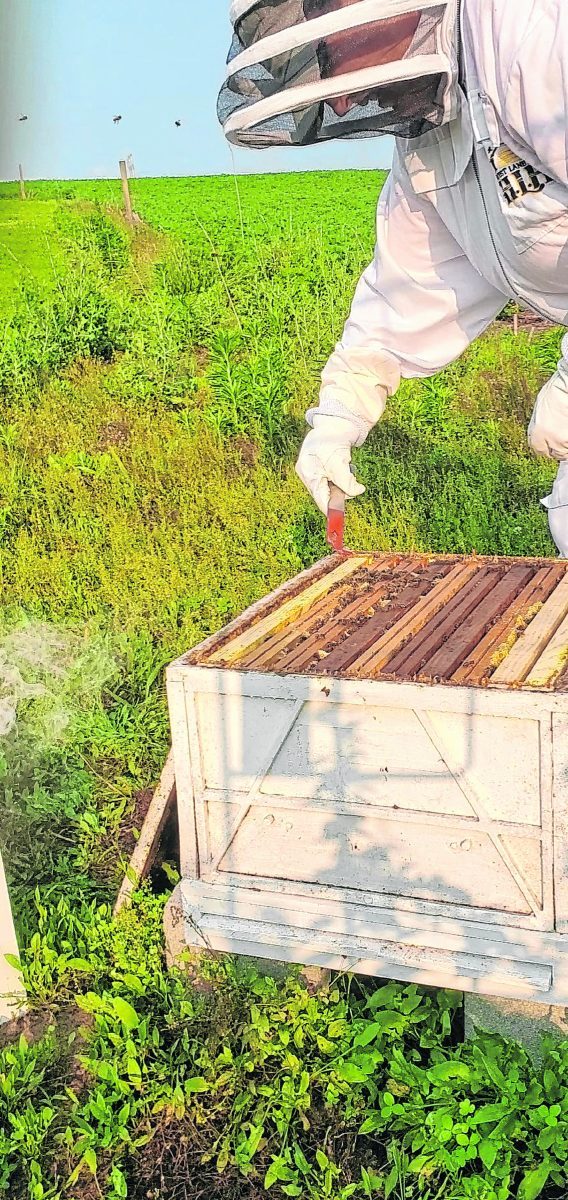
Well, it’s official. I’m an initiated beekeeper. I received my first sting tending to the hive.
I knew from the beginning that stings were part of beekeeping, just like tending to chickens usually results in getting a peck here and there when retrieving eggs.
Just as I did with the chickens, I’ve read almost everything to learn about these new apis on my property. I’ve learned when I see things happening, such as hive beetles and the ever-present threat of varroa mites, but my work in the hive a few weekends ago eluded any reading I had come across.
I like to check the bees during the hottest part of the day when most of the bees are out of the hive and foraging. It’s miserable for me but seems to be a lot less stress for the bees. Imagine donning a long-sleeved cotton jumpsuit, zipping it up as tight as you can and then walking about 300 feet to the hive with a pot of hot, smoking wood chips.
The latter apparatus is what you need to use to smoke the hive and calm the bees when you open the top. Any sane person would disagree to any of that, but I guess since I’m a crazy chicken lady, it just came natural to be a crazy bee lady, as well.
I pulled each of the frames out of the deep hive box that Saturday afternoon, looking for all of the things I had read about: Eggs, larvae, honey, capped brood, etc. Each frame told a different story. Some had lots of capped honey. Others not so much honey but new and emerging bees and the ever-present workers, who as you’ve read before are all female.
I was feeling confident in my hive inspection, pulling frames like a seasoned beekeeper, when I hit a snag on the last two frames.
Bees connect things in the hive with a very sticky substance called propolis, and it acts as glue to hold things in place. This stuff also seals cracks against moisture and drafts. Leave it to the humble bees to create their own spackling.
I worked the last frame, trying to pry it loose from the propolis.
These buzzing creatures also form “bridges” of honeycomb when there is a large enough gap between frames that they aren’t able to crawl from one spot to another. It was one of these connecting bridges that caused the center of a frame of honeycomb inside the hive to fully collapse in on itself as I pulled the frame from the hive.
I heard the buzzing of the bees increase and knew I had completely wrecked their hard work, and man, they weren’t happy about it at all.
Apologizing, I fixed the hole as best as I could and put the frame gingerly back inside the hive. Little bee faces stared accusingly up at me as if to say, “What did you do?” as I closed the hive lid.
A day or so later, I walked down to the hive to check on the bees after my homewrecking. I haven’t had to wear protective gear, such as a bee suit, to just stand about 10 feet from the hive in the past, so I wasn’t too worried about wearing just a short-sleeved T-shirt and shorts.
Within 12 feet of the hive, I suddenly felt a sharp stab on my right forearm. Yup, you guessed it, there was a worker bee who was telling me on no uncertain terms that she remembered what I had done and she was going to try to ensure I never returned to wreck their home again.
I’m fortunate it appears I’m not deathly allergic to bee stings, but gosh that little sting itched for several days afterward. I guess that little bee got her revenge for what I did. Thank goodness the chickens don’t go to that extreme when something goes wrong in the coop.
Until next time…
Stephanie Strothmann owns Purple Shamrock Farm LLC in rural Seymour. Read her blog at whattheclucker.blogspot.com. Send comments to [email protected].
